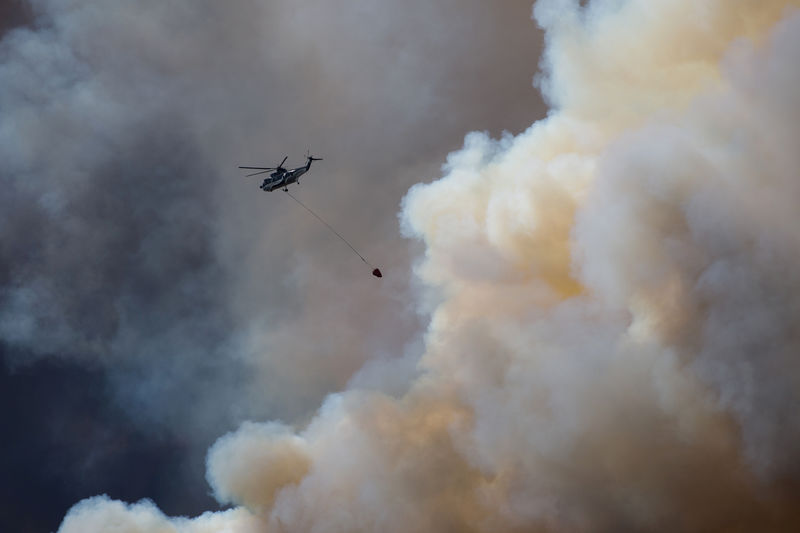* More than 1 mln bpd in Canadian oil supply offline
* Statoil , Husky latest firms that shut plants as precaution
* Restarting production will take weeks - analysts
* CNOOC facility suffers damage, first for energy in fire
(Updates throughout, adds details, quotes)
By Barani Krishnan
NEW YORK, May 9 (Reuters) - Oil producers and refiners
braced on Monday for a prolonged shutdown and possible supply
constraints from Canada's vast oil sands region as a destructive
wildfire raged for a second week.
Cooler and possible wetter weather looked to help
firefighters battling the massive blaze as Canadian officials
planned to take their first look at oil boom town Fort McMurray.
The town has been ravaged by the nation's most destructive
wildfire in recent memory, with about half of the nation's oil
sands capacity remained shut as energy firms kept facilities
closed as a precaution.
Officials said resuming operations would be a challenge and
no timeline had been considered.
"This production is not gone for good, yet when fires are
controlled, restarting production will take several more weeks,
even without damage," energy analysts at Morgan Stanley (NYSE:MS) said in
a note.
BP and other big oil firms warned on Friday they would not
be able to deliver on some contracts.
Statoil STL.OL and Husky Energy Inc HSE.TO were among 11
production companies and three pipeline operators that have
curbed activities after the inferno that began on May 1 forced
more than 1 million barrels of capacity offline.
The yard of CNOOC 0883.HK unit Nexen's facility in Long
Lake, Alberta, suffered minor damage on Sunday from fire,
officials said. It was the first reported damage to an energy
industry asset since the crisis began.
Speculators' bullish bets on U.S. crude futures CLc1 were
near July highs while bullish trades on global oil benchmark
Brent LCOc1 were already near record highs. The scope for
further gains was limited until there was more clarity on the
extent of damage to oil facilities or supply outages. WTI crude
was off 1.5 percent, while Brent fell 2.1 percent. O/R
The market has risen about 75 percent since hitting 12-year
lows of around $27 or lower in the first quarter, supported by
falling U.S. production, unexpected supply constraints in Libya
and the Americas as well as a weaker dollar.
Last week, Canadian crude futures rallied to their highest
in months from the production cuts. CRU/CA
"It is likely that the market will over-react," said Jim
Williams, an analyst at WTRG Economics in London, Arkansas. "My
worry is if the upgrader facilities that push out the bulk of
the heavy Canadian crude to the U.S. get damaged. Then you have
a big problem."
On Friday three firms issued warnings of "force majeure"
events, including BP Plc BP.L BP.N , which produces oil in
Canada via a partnership with Husky, Suncor Energy Inc SU.TO ,
the largest Canadian oil producer, and U.S. refiner Phillips 66 (NYSE:PSX)
PSX.N .
Force majeure is an unforeseen event that prevents a party
from fulfilling a contract. The notices were for the inability
to deliver on some contracts for Canadian crude.
The United States imports about 3.5 million barrels a day of
Canadian crude, which is particularly important for U.S.
refiners from Ohio to the Dakotas.
World oil supplies remained in a glut, with an estimated
oversupply of about 1.5 million bpd.
Record U.S. inventories and plentiful supplies in storage in
western Canada will offset some of the losses from the blaze.
But prolonged outages in the oil sands, which has the world's
third-largest crude reserves, could roil producers and traders'
contracts and order books.
According to Genscape, which monitors key crude storage
terminals in western Canada, including critical locations in
Edmonton and Hardisty, total inventories were 26.5 million
barrels at the end of April, equivalent to less than a month of
output currently offline.
"We are going to see this impacting flows, not necessarily
right away, but over the next few weeks," said Matt Smith, who
tracks crude cargoes for New York-based Clipper Data. "An outage
of this volume is going to have a supportive influence on the
market."
